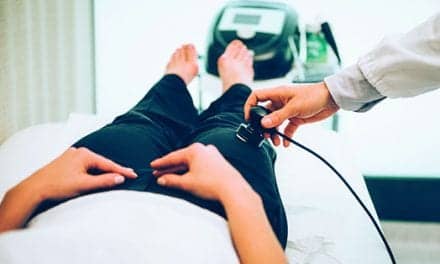Integrating job requirements and functional testing into treatment can optimize an injured worker’s return to work.
Physical therapy treatment goals typically focus on increasing the patient’s strength and range of motion along with decreasing symptoms, rather than focusing on return to work as a primary goal. In some cases, the patient is discharged from therapy only to find out that he or she is unable to perform the required job duties to sustain return to work. To facilitate return to work, therapists must become familiar with the patient’s actual job requirements and integrate them into the treatment process. Therapists can assist return to work by identifying modified duty options for employers, allowing workers to safely return to work when they can perform part of their job duties. Treatment continues as needed until the worker can perform 100% of their job duties.
Optimizing Return to Work Efforts
Many factors influence an injured worker’s return to work, including the specific diagnosis and medical care, personal coping skills, workplace systems, and the regulatory environment. Optimizing the process involves removing barriers that delay or disrupt the process. In addition, communication between all parties regarding the worker’s functional ability is of utmost importance.
Research in the area of work disability and occupational health supports the following:
• The positive benefits of early or transitional return to work. Injured workers offered transitional work may return up to twice as fast as those not offered transitional work.
• Return to work involving function-based strengthening results in less time in formal rehabilitation.
• Having specific work goals have been shown to help return to work outcomes.
• An early return-to-work focus can minimize the disabling effects, financial stressors, and psychological impact of injury.
• Collaboration among the employer, worker, and medical team members can lead to tailored return-to-work plans.
Statistics from the Official Disability Guideline (ODG) indicate that 50% to 70% of people with nonspecific soft-tissue injures are back to work at 3 weeks. Variables to this timeline include the type of injury, availability of work modifications, type of work performed, and understanding of the job requirements, to name a few. However, it is clear that workers do not need to wait until they are completely pain free or 100% to return to work, as long as tissue healing continues while promoting function.
The best practice for most soft-tissue problems has been to be as active as possible. Early mobilization, including earlier return to work, results in benefits including decreased pain, swelling, and stiffness, and greater range of joint motion. Rest and immobilization are not generally recommended. A discussion of common healing timelines can help set worker expectations, planning, and problem-solving. Activity modifications can help facilitate the transition toward performing activities of daily living and work. Modified or full-duty return to work can be considered as soon as the condition permits, many times within several days or weeks after injury. As long as the involved body part is protected and not worsened or compromised, return to work can be considered. Work planning should take the job requirements and the degree of injury into account to optimize return to the workplace.
Functional testing performed by a specialty trained physical therapist early in the treatment process will help identify when the patient/worker has the ability to safely perform the essential physical requirements of his or her job or modified work, if available. Transitional or modified duty work can include lighter physical demands, temporary assistance with job activities, and/or gradual increase in activities and job duties.
Appropriate functional testing should be based on worker diagnosis, presentation, and limitations and the required job duties. It is critical that therapists understand the physical requirements of the job. A job description may be provided by the employer, the therapist may need to talk with the supervisor to understand the specific job requirements, or a site visit may be needed. It is most helpful when the job requirements link with the physical job demands.
The following job description for a truck loader position illustrates an example of a job description with distinct detailed job functions and activities outlined:
Job Description: Truck Loader
Job Function: Load products onto trailers according to drop sequence and loading procedures
Activity: Assemble bulk loaded products
• Floor to Waist Lift (Rarely) 40 pounds to assemble bulk loaded products
• Waist to Crown Lift (Rarely) 40 pounds from 5 inches to 36 inches to assemble bulk loaded products
Activity: Operate rider pallet truck (end control)
• Stair climb (Occasionally) one step, each step height is 11 inches, to operate rider pallet truck
• Stand (Frequently) to operate rider pallet truck
• Right or Left Hand Coordination (Frequently) to operate rider pallet truck
Activity: Transfer ice cream containers from pick slots and dry ice from dry ice bin into ice-cream bags and load onto forklift
• Floor to Waist (Rarely) 16 pounds transfer ice cream containers from pick slots and dry ice from dry ice bin
• Pulling (Rarely) horizontally at self-selected height with a force of 67 pounds up to 5 feet indoors on a smooth surface to transfer ice cream containers from pick slots and dry ice from dry ice bin
Activity: Load chemicals from pallet to trailer floor
• Floor to Waist Lift (Occasionally) 62 pounds to load chemicals from pallet to trailer floor to load products onto trailers
In this example, once the patient/worker was able to lift 40 pounds rarely from floor to waist and lift 40 pounds rarely overhead, he or she could perform all job duties required of a truck loader with the exception of loading chemicals from pallet to trailer floor. For this task, assistance of a co-worker could be considered or even eliminating the task from the job altogether until he or she can safely lift 62 pounds floor to waist. Modifying current job duties allows earlier return to work.
Equipment Considerations for Functional Testing
The equipment involved in return to work testing should replicate the job functions or job requirements (for some or all of the tasks). The equipment first establishes baseline performance; repeat testing will assess functional gains.
In addition, patients/workers relate to equipment that replicates what they do on the job, and it gives them increased confidence in returning to work knowing they have the capability of performing the various tasks required of them. Physicians are more likely to release the worker to work knowing the worker can indeed perform the required job tasks, and employers are more likely to take the worker back knowing exactly what the worker will be able to do upon their return. A job description that clearly outlines the job requirements and tasks will facilitate earlier and sustained return to work.
Some clinical facilities are not large enough to store much employer-specific equipment, may not routinely work with the same patient, or there may be limitations in the materials leaving the workplace. Generalized equipment which attempts to replicate load, dimensions, handholds, etc, may be used in these instances, although more explanation may be needed to specifically link the therapy task to the work task to help build self-confidence with the patient/worker.
Common equipment used to replicate work function includes the following:
1) Equipment or product from the employer, such as cases of outdated beverage, hand trucks, etc. Employers often have equipment or product that can be used in the clinical setting.
2) Adjustable Shelving Unit: WorkWell worked locally with a company to design an adjustable-height shelving unit that was easily adjustable, sturdy, and could hold up to 200 pounds per shelf. It is available through www.workwell.com. A similar unit is available through Lodi, Ohio-based Bailey Manufacturing Company.
3) Force gauges: These can include Jamar hand dynamometers, found through Patterson Medical, Warrenville, Ill, and Shimpo force gauges, available through ShimpoInstruments.com by ELECTROMATIC Equipment Co, headquartered in Cedarhurst, NY, and The Human Solution, Austin, Tex.
4) Various size weight crates: WorkWell uses a 12- by 12- by 12-inch “milk crate,” available through www.workwell.com; others are available through Bailey Manufacturing Company. Hausmann Industries Inc, Northvale, NJ, also markets weight boxes that include “Stockroom Crates” and “Packing Cartons.” A variety of lift boxes can also be found through The Back School, Atlanta.
5) Weights, such as dumbbells or cuff weights: These items are available through companies such as www.RehabMart.com, as well as Meyer Distributing Company, Hudson, Ohio, and Libertyville, Ill-based SPRI Products.
6) Tool box: Available at www.workwell.com
7) Step ladder: Werner 375-pound load tolerance; Lowes or Home Depot
8) Computer, mouse, keyboard: multiple brands of keyboards with mouse are available.
9) Various hand coordination boards: WorkWell uses the Minnesota Manual Dexterity Test and Purdue Pegboard, available at www.workwell.com. Lafayette Instrument Company, headquartered in Lafayette, Ind, also offers a range of dexterity tests, including the Grooved Pegboard and the Hand Tool Dexterity Test.
Physical therapists can assist earlier return to work when the job requirements are identified and when functional testing becomes part of the treatment plan of care. In addition, by identifying modified duty options for employers, workers can be returned to work before they are able to do the job 100%. The goal is to return the worker to work as soon as possible, keeping them safe until they can fully perform the job duties. PTP
Margot Miller, PT, is chief clinical advisor for WorkWell Prevention and Care. She can be reached at [email protected]. For more information, contact [email protected]
Resources
Bethge M1, Herbold D, Trowitzsch L, Jacobi C. Work status and health-related quality of life following multimodal work hardening: a cluster randomised trial. J Back Musculoskelet Rehabil. 2011;24(3):161-172.
Dunning KK1, Davis KG, Kotowski SE, Elliott T, Jewell G, Lockey J. Can a transitional work grant program in a workers’ compensation system reduce cost and facilitate return to work? J Occup Environ Hyg. 2008 Sep;5(9):547-555.
Hoefsmit N1, Houkes I1, Nijhuis F2. Environmental and personal factors that support early return-to-work: a qualitative study using the ICF as a framework. Work. 2014;48(2):203-215.





